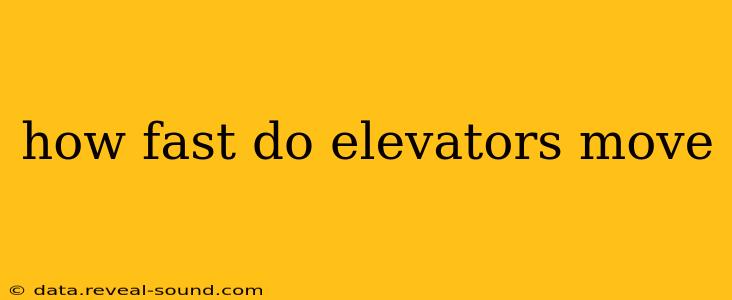How Fast Do Elevators Move? A Deep Dive into Elevator Speed
Elevators, those ubiquitous vertical transportation systems, move at varying speeds depending on several factors. There's no single answer to "how fast do elevators move?", as the speed is influenced by building height, passenger capacity, and technological advancements. Let's explore the nuances of elevator speed and address some common questions.
What is the average speed of an elevator?
The average speed of a passenger elevator in a typical office building or residential high-rise is between 100 and 400 feet per minute (fpm). This translates to roughly 1-4 mph. However, this is just an average; many factors influence the actual speed.
How fast are the fastest elevators in the world?
The fastest elevators in the world reach speeds significantly higher than the average. Some high-speed elevators in skyscrapers like those in Taipei 101 or the Shanghai Tower can reach speeds exceeding 20 meters per second (approximately 45 mph or 720 fpm). These elevators utilize advanced technologies to achieve such remarkable speeds while ensuring a smooth and comfortable ride for passengers.
What factors affect elevator speed?
Several factors contribute to the speed of an elevator:
- Building Height: Taller buildings generally require faster elevators to minimize travel time. A short building might only need an elevator capable of a slower speed, while a skyscraper needs significantly faster ones.
- Passenger Capacity: Elevators designed to carry more people tend to be slower than those with smaller capacities. This is partly due to the increased weight and the need for more robust safety mechanisms.
- Technology: Modern elevator technology, including advanced control systems and more efficient motors, allows for faster and smoother operation. Older elevators naturally operate at slower speeds.
- Counterweights and Drive Systems: The design of the counterweight system and the type of drive system (hydraulic, traction, etc.) significantly impact speed and efficiency.
- Safety Regulations: Safety regulations and building codes influence the maximum allowable speed for elevators in a given location.
What are the different types of elevator drive systems, and how do they affect speed?
There are primarily two types of elevator drive systems that influence speed:
- Traction Elevators: These use steel ropes and a motor to lift the elevator car. Traction elevators are generally faster and more efficient for taller buildings. High-speed elevators almost exclusively utilize traction systems.
- Hydraulic Elevators: These use a hydraulic piston to lift the elevator car. They are typically slower and less efficient than traction elevators and are more common in low-rise buildings.
Are there any safety concerns regarding high-speed elevators?
While high-speed elevators offer convenience, safety is paramount. Sophisticated safety features, including emergency brakes and sophisticated control systems, are crucial to mitigate risks. These systems ensure the elevator stops safely in case of malfunctions or emergencies. Regular maintenance and inspections are essential to maintaining safety standards.
How is elevator speed measured and controlled?
Elevator speed is precisely measured and controlled through various sensors, computer systems, and control mechanisms. These systems monitor speed, position, and other vital parameters, ensuring smooth and safe operation within pre-defined limits. The control systems also manage factors like acceleration and deceleration for a comfortable ride.
In conclusion, the speed of an elevator is not a fixed value but rather a variable influenced by several factors. While the average speed might fall within a certain range, the fastest elevators in the world are significantly faster, showcasing continuous advancements in elevator technology. Safety remains a primary concern, with multiple systems ensuring smooth and secure transportation for passengers.
